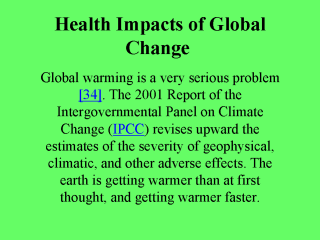 |
Alpine glaciers
and ice-caps in Africa, the Americas, Europe, even much of the Himalayas, are receding,
some could disappear altogether, with devastating consequences for river flow and
downstream irrigation. Wetlands are drying out, rainfall patterns are changing, weather
extremes (floods, hurricanes, droughts, etc) are all becoming more frequent and more
severe at a greater rate than originally estimated. The health impacts of all these
processes could be devastating, and will affect huge numbers of people. For example, an
increase in the average ambient temperature of half to one degree Celsius would expand the
range of malaria-carrying mosquitoes into temperate zones and higher altitudes that would
put almost a billion additional people at risk. Melting of polar and alpine icecaps and
thermal expansion of the sea water mass is expected to raise sea levels by about 50 cm in
the next 50 years. Half a billion people live very near sea level; their habitat,
especially in small island states will disappear or be threatened with inundation. Climate
change also threatens food security, by leading to less predictable weather patterns and
growing seasons, and more frequent extreme weather (floods, droughts). Climate change
forces people to migrate as environmental refugees, and thereby imposes severe strains on
public health services, many of which are already stretched to the limit because tax
revolts and budget cuts have led to deterioration of public health infrastructure. |
